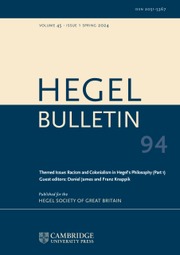No CrossRef data available.
Article contents
For a Reading of Lordship and Bondage: The Genesis of Practical Reason as a Way to Hegel's First Philosophy
Published online by Cambridge University Press: 18 July 2023
Abstract
In the following essay I shall propose a reading of Lordship and Bondage that follows what Robert Pippin termed a ‘practical turn’ (Pippin 2011: 28). I shall further argue that this turn ought to be qualified as Hegel's first philosophy. Starting with a reading that evinces the connection between the practical achievement of Self-Consciousness and the notion of Spirit as exhibiting a concentric relation, Spirit will be revealed to have its centre in the practical achievement of Self-Consciousness. I will then offer a commentary on the notion of a complex desideratum as a way of attaining the concept of desire at work in the Phenomenology. The commentary will show that Hegel frames the satisfaction of this desire as a distinctive problem that will in turn necessitate a proper practical solution. This leads us to the implicit critique of contractualism, that may—in the terms of Hegel's argument—function as an impediment to the proper philosophical understanding of reciprocity. To conclude I shall propose a reading within the intrasubjective family of readings. We will find that the critique of both contractualism and the apprehension of the complex desideratum offers us the rationale for interpreting the peculiar absence of fear in Hegel's allegory of life-and-death struggle. I shall offer a detailed reading of the Lord and Bondsman trope and interpret these two figures as two aspects of one self-conscious individual in the process of apprehending their practical nature, thus making explicit a tripartite structure of practical self-consciousness. This will be suggested as the solution to the initial orectic problem and the beginning of an argument towards the practical attainment of Spirit.
Information
- Type
- Research Article
- Information
- Copyright
- © The Author(s), 2023. Published by Cambridge University Press on behalf of The Hegel Society of Great Britain


